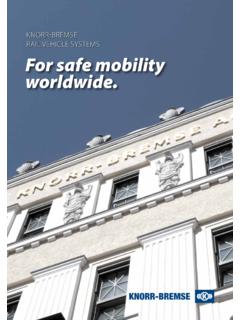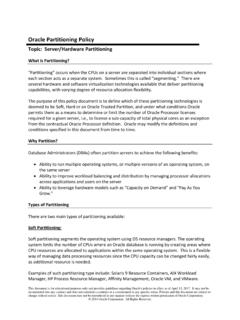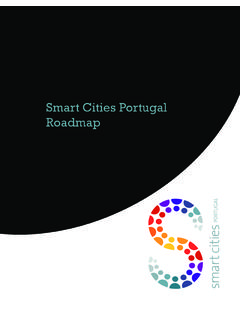Transcription of Disruption Technology in Mobility - Customer …
1 Disruption Technology in Mobility - Customer acceptance and Examples To be published in Khare, A., Stewart, B. & Schatz, R. (eds.), Phantom Ex Machina Digital Disruption 's Role in Business Model Transformation. Springer 2017. Robert Bongaerts, Marta Kwiatkowski and Tatjana K nig Abstract Important things become part of our language. "Do not reinvent the wheel" is an old German proverb, which refers to one of the most important "breakthrough" inventions (the wheel) in the area of Mobility a need of still increasing importance in today's societies. The history of Mobility knows many more examples of disruptive technologies - all of them changed and shaped our world as we know it today.
2 Recent disruptive innovations within the Mobility refer to Simple and cost-effective access to Mobility : The example of Uber shows how motorized private means of transport can become part of public transport. Technological development: Tesla demonstrates impressively that eco-friendly electric cars with sporty design can beat traditional car Technology . Self-driving cars are on their way and even telekinesis (steering by thinking) seems possible. New Mobility Dimensions: Companies like Space X work on commercialising space travels for private consumers, thus opening the door to interplanetary tourism and super-high-speed- travelling. For every innovation there are two challenges: The first challenge is to invent it, all about engineering and Technology , the second one is to market it, all about mind and design that shape the Customer perspective.
3 And both of them do not just consist of make-or-break leaps, but are continuous processes on the way to the breakthrough, and beyond. The Map of Disruption combines these two perspectives and provides a useful visualization on what is technically feasible and what is profitably marketable. We start off by illustrating major trends in Mobility and the challenges emerging from them. Section two provides the theoretical basis for the market acceptance of disruptive innovations: value theory as a general framework for consumer decision-making and the Technology acceptance Model (TAM) as a particular framework for technological innovations. In the third step we introduce the Map of Disruptions.
4 Finally, we integrate examples of disruptive technologies in the Mobility business in the Map of Disruptions. We conclude by providing explanations why some technological innovations in the area Mobility are accepted by the market and become potentially disruptive technologies whereas others don't succeed. Keywords: Mobility , Technology acceptance Model (TAM), Sharing Economy, Self-driving Car, Map of Disruption , Disruptive Technology and Consumer acceptance , Simplexity. 1. Challenges for Mobility More than 2,000 years ago Heraclitus (540-480 BC) mentioned: All life is motion. At least in the western world Mobility has become a more or less basic need. Mobility is part of most people's lives.
5 Mobility is a real success story, but unsolved problems still exist and new challenges arise. We want to discuss these problems and challenges by integrating different perspectives: the user or consumer perspective, the supplier perspective, and the governmental / societal perspective. Key challenges for the Mobility of the future arise from the megatrends of our time: demographic change, urbanization, increasing environmental awareness and shifting Mobility behavior: Looking at the demographic trends, the Mobility industry has to face two mayor issues: Firstly, according to the , in the next 30 years the total population of the earth will grow to 10. billion people.
6 In consequence an overall increase both of passenger transport (individual or public) and - even more - of freight traffic will challenge existing Mobility capacities. Secondly, especially in the industrialized countries, the ageing of societies is likely to be a key issue. In Germany, for example, the share of people at the age of 65 years and older will have doubled by 2060 and will amount to one third of the population (StBA, 2015). Rising age might sooner or later limit physical Mobility of the human body, and therefore raise the requirements and challenges for most suppliers in the Mobility sector. On a worldwide basis, some 50 % of the population live already in cities.
7 This portion is expected to rise to more than 65% by 2050 (UN, 2014). In Europe, this ratio has already been reached and it is expected to further rise to amount to some 85% in the long run. Urbanization will have a strong impact on infrastructure. To prevent traffic collapse of cities and a further rise in cost of infrastructure, Mobility solutions are needed that optimize the utilization of existing infrastructure and achieve a higher efficiency. Public passenger transport is already testing alternatives in rural areas: Swiss-based PostAuto is testing self-driving busses (PostAuto, 2015). Rethinking ownership: At least in the triad markets, car loses its significance as a status symbol or a statement of personal expression (Rossbach et al.)
8 , 2013). This is especially true for the young, educated consumer in metropolitan areas. Even though car numbers are still growing on a worldwide basis, we see declining numbers in some countries and especially in some bigger cities indicating that the peak car has been exceeded (Newman & Kenworthy, 2015). In big cities in Germany the percentage of households without a car increased from 22% in 2003 up to 30% in 2013 (StBA, 2014). Alternative Mobility concepts such as car sharing experienced unprecedented Customer acceptance . Connected Mobility : In addition, a new trend called intermodality, the flexible and individual combination of different modes of transport, is increasingly gaining relevance.
9 What is important to the Customer is the most efficient way to get from A to B, not the means of transport used or who owns them. Connected Mobility aims at integrating various means of transport into one comprehensive transport system instead of competing against each other. A key element is the flexible choice of the most appropriate combination of transport means for a transport purpose. Separate information, booking and ticketing systems for the various competing modes of transport belong to the past. A Mobility integrator assumes the role of a comprehensive Mobility service (Fraunhofer, 2016). Mobility consumers are increasingly expecting one-fits-all-solutions and connected Mobility (Henkel, Tomczak, Henkel & Hauner, 2015).
10 However, in this area integrated solutions from the supplier side seem to lag behind. Living in a digital world: Thanks to smartphone and wearable permanent access to the Internet has become standard. The triumph of smartphones changes how and when we access 2. information, buy, sell, use, and communicate about products or services. As a side effect, Customer needs are growing in the dimensions simplicity / convenience, real-time solutions, and ubiquity. Messenger Apps are the most growing social platforms, becoming soon the way to communicate with friends and family but also with business (Wolf, 2015). From a governmental / societal perspective the challenges concerning Mobility are: Rural Depopulation: Urbanization leads to higher costs of infrastructure not only in the fast growing megacities of the world.






